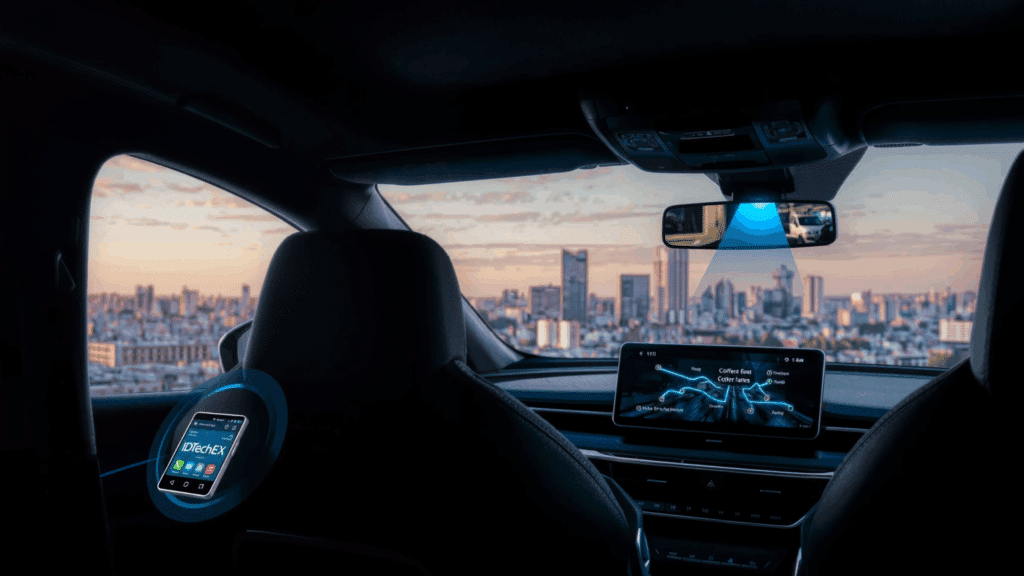As the trend of vehicle intelligence enhancement rises, in-cabin sensing systems will be largely responsible for increased communication, sensitivity, and smart features within cars. IDTechEx‘s report, “In-Cabin Sensing 2025-2035: Technologies, Opportunities, and Markets“, provides the latest technology developments within the sector, along with forecasts for their uptake over the next ten years.
Where AI meets in-cabin sensing
Monitoring drowsiness and detecting the occupancy of children in rear seats are two examples of traditional uses for in-cabin sensing, though with the implementation of AI and advanced software, features such as facial recognition for secure payment features can also be enabled. This will allow for the creation of smart automotive interiors, potentially allowing for some OEMs to gain competitive advantages over others.
Advanced driver distraction warning (ADDW) is becoming necessary for OEMs to include, and the deployment of AI could move vehicle interiors from simply meeting minimum safety standards to creating personalized user experiences, signifying changes in vehicle intelligence. AI could work to enhance the already essential use of near infrared (NIR) for gaze detection, face detection, face analysis, and facial recognition – parts that make up the driver monitoring system (DMS).
Up and coming trends of in-cabin sensing
In-cabin sensing with AI can be used to provide ease for the driver, perhaps by an AI assistant suggesting a stop for coffee when the car detects fatigue in the driver. IDTechEx’s report, “Software-Defined Vehicles, Connected Cars, and AI in Cars 2026-2036: Markets, Trends, and Forecasts“, explores the connectivity between vehicles on the road and their surroundings, as well as enhanced communication between the vehicle and the driver. Empathetic interfaces are another phenomenon explored in IDTechEx’s In-Cabin Sensing report, where software can be used to interpret human behaviour and emotion such as stress. Changes in voice tone or gestures could become signals for the vehicle that the driver may require a break from driving.
Radio station changes and other personalization features could be prompted in line with cameras and sensors analyzing preferences of the driver, as they could be able to detect mood through facial expressions or gestures. Personalized vehicle settings could also ensure the seat is positioned correctly and that the car climate is adjusted based on which passengers enter the vehicle, for a tailored and considered driving experience.
Prioritizing safety and accuracy
With the goal to deploy as few sensing technologies as possible to produce the most effective and accurate systems, cameras may be utilized instead of capacitive sensors to detect whether the driver has their hands on the wheel. Some trends that could be seen going forward may include OEMs opting for RGB+IR systems for occupant monitoring systems (OMS) in low-end vehicles, and multiple sensors, including radar, in mid- to high-end vehicles.
Radar technology for OMS systems can pick up on a multitude of information such as seat occupancy, seat belt detection, airbag deployment, and automated air conditioning systems. This may provide peace of mind for parents when children are in the back, knowing that they can be monitored by the vehicle on long journeys. Vital signs of passengers could also be detected by radar technology, including heartrate or breathing rate, to ensure the welfare of everyone is optimized, while being done discreetly and seamlessly.
IDTechEx’s report, “In-Cabin Sensing 2025-2035: Technologies, Opportunities, and Markets“, provides in-depth research into the many technologies that make up the parts of in-cabin sensing systems, including DMS and OMS specific features. For more information, visit the portfolio of Robotics & Autonomy Research Reports for subscription access and an extensive list of reports.


